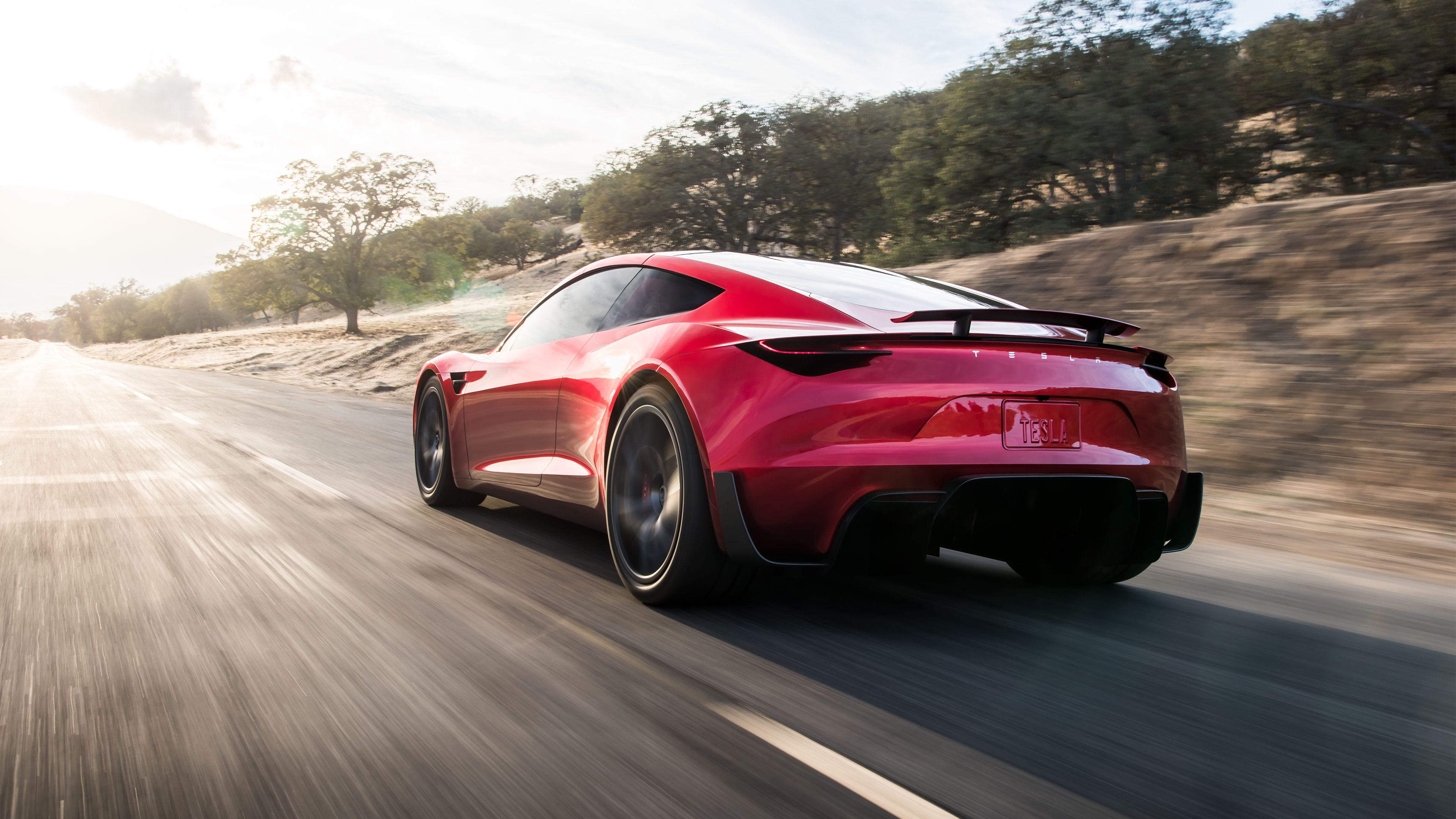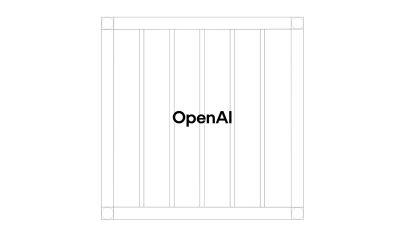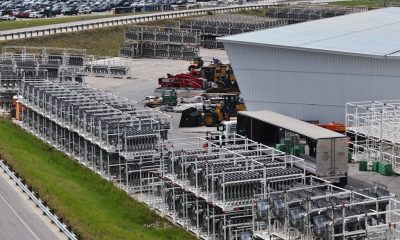

News
Tesla Roadster’s ‘SpaceX package’ with rocket thrusters could actually work
This weekend proved to be a fruitful one for Elon Musk’s Twitter followers and fans of the next-generation Tesla Roadster, as the billionaire entrepreneur discussed, in honest-to-goodness seriousness, how the electric car maker would utilize SpaceX technology to make the upcoming all-electric supercar an absolute monster on wheels. Needless to say, there was quite a lot to take in.
Musk started off his Twitter discussion on the next-generation Roadster by stating that the car will feature ~10 rocket thrusters that are “arranged seamlessly around (the) car.” Musk further noted that the thrusters would “dramatically” improve acceleration, braking, and cornering, to the point that the Roadster would be able to fly — a reaffirmation of his previous statement referring to the vehicle having the capability to fly “short hops.”
Musk noted that Tesla would be using SpaceX’s Composite Overwrapped Pressure Vessel (COPV), a container consisting of a thin, non-structural liner wrapped with a structural fiber composite. COPVs are designed to hold a fluid under pressure, and are used by SpaceX’s first-stage rocket boosters during re-entry and landing. Musk further explained the use of SpaceX’s technology in later tweets.
SpaceX option package for new Tesla Roadster will include ~10 small rocket thrusters arranged seamlessly around car. These rocket engines dramatically improve acceleration, top speed, braking & cornering. Maybe they will even allow a Tesla to fly …
— Elon Musk (@elonmusk) June 9, 2018
While the idea of using rocket propulsion to enhance the performance of an all-electric supercar might seem to be well into the realms of science fiction, using COPVs for the next-gen Roadster is actually pretty feasible, at least from a technical standpoint. SpaceX’s COPVs have operating pressures of around 350 bars (5,000 psi) and too powerful for a land vehicle. If Tesla installs a similar version of SpaceX’s upper stage thrusters that are used in guiding rockets, rear-mounted devices could store just enough compressed air to provide Tesla’s next-gen Roadster an additional boost in acceleration for a short duration.
Note, gas contained would be ultra high pressure air in a SpaceX rocket COPV bottle. The air exiting the thrusters would immediately be replenished whenever vehicle pack power draw allowed operation of the air pump, which is most of the time.
— Elon Musk (@elonmusk) June 10, 2018
Rocket thrusters placed in front of the vehicle that provides thrust opposite of the Roadster’s direction of travel, at least in concept, could help the electric car’s braking capability, while thrusters placed along each side of the vehicle can help in cornering by providing lateral force. In order to accomplish this, however, Tesla would have to carefully balance the weight of components from the upgraded SpaceX package – Musk noted that the vehicle would sacrifice its rear seats from the standard 2+ 2 configuration to accommodate the additional hardware – with output from the rocket thrusters to maximize the vehicle’s performance. Onboard electric air pumps would repressurize the space-grade containers when they were depleted, making for repeat fun, at least in a theoretical sense. Musk also stated that SpaceX COPVs that will be used for the next-generation Roadster will be durable, and be “literally bulletproof.”
Exactly. Total energy stored even in ultra compressed air is low vs battery, but power output is insane. The composite overwrapped pressure vessel (COPV) is most advanced ever made. It’s what SpaceX is qualifying for NASA crewed missions. Extremely robust — literally bulletproof.
— Elon Musk (@elonmusk) June 10, 2018
Overall, Musk reiterated that the next-generation Tesla Roadster is designed to be the best car in the industry when it gets released. During his tweetstorm, Musk mentioned that with the all-electric supercar, Tesla is attempting to beat ICE vehicles on “every performance metric;” thus transferring the “halo crown effect” gas cars have as the top speed standards in the automotive market.
New details about Tesla’s next-generation Roadster have been released by Elon Musk lately. The SpaceX option for the vehicle was announced during the 2018 Annual Shareholder Meeting, and not long after that, Musk also revealed that the vehicle would feature an “Augmented Mode” designed to “enhance human driving ability,” thereby providing assistance to drivers who would be operating the insanely powerful supercar.
During the unveiling of the next-generation Tesla Roadster, Elon Musk noted that the purpose of the all-electric supercar is to give a “hardcore smackdown” to gasoline-powered cars. The specs of the vehicle that were unveiled then, which are representative of the all-electric supercar’s base trim, are already record-breaking, including a 0-60 mph time of 1.9 seconds, a quarter-mile time of 8.9 seconds, a top speed of over 250 mph, 620 miles of range thanks to a 200 kWh battery, and 10,000 Nm of torque. With the Roadster’s SpaceX option, the all-electric supercar could very well establish a new class of vehicles that lie beyond the hypercar echelon.
News
These Tesla, X, and xAI engineers were just poached by OpenAI
The news is the latest in an ongoing feud between Elon Musk and the Sam Altman-run firm OpenAI.

OpenAI, the xAI competitor for which Elon Musk previously served as a boardmember and helped to co-found, has reportedly poached high-level engineers from Tesla, along with others from xAI, X, and still others.
On Tuesday, Wired reported that OpenAI hired four high-level engineers from Tesla, xAI, and X, as seen in an internal Slack message sent by co-founder Greg Brockman. The engineers include Tesla Vice President of Software Engineering David Lau, X and xAI’s head of infrastructure engineering Uday Ruddarraju, and fellow xAI infrastructure engineer Mike Dalton. The hiring spree also included Angela Fan, an AI researcher from Meta.
“We’re excited to welcome these new members to our scaling team,” said Hannah Wong, an OpenAI spokesperson. “Our approach is to continue building and bringing together world-class infrastructure, research, and product teams to accelerate our mission and deliver the benefits of AI to hundreds of millions of people.”
Lau has been in his position as Tesla’s VP of Software Engineering since 2017, after previously working for the company’s firmware, platforms, and system integration divisions.
“It has become incredibly clear to me that accelerating progress towards safe, well-aligned artificial general intelligence is the most rewarding mission I could imagine for the next chapter of my career,” Lau said in a statement to Wired.
🚨Optimistic projections point to xAI possibly attaining profitability by 2027, according to Bloomberg's sources.
If accurate, this would be quite a feat for xAI. OpenAI, its biggest rival, is still looking at 2029 as the year it could become cash flow positive.💰 https://t.co/pE5Z9daez8
— TESLARATI (@Teslarati) June 18, 2025
READ MORE ON OPENAI: Elon Musk’s OpenAI lawsuit clears hurdle as trial looms
At xAI, Ruddarraju and Dalton both played a large role in developing the Colossus supercomputer, which is comprised of over 200,000 GPUs. One of the major ongoing projects at OpenAI is the company’s Stargate program,
“Infrastructure is where research meets reality, and OpenAI has already demonstrated this successfully,” Ruddarraju told Wired in another statement. “Stargate, in particular, is an infrastructure moonshot that perfectly matches the ambitious, systems-level challenges I love taking on.”
Elon Musk is currently in the process of suing OpenAI for shifting toward a for-profit model, as well as for accepting an investment of billions of dollars from Microsoft. OpenAI retaliated with a counterlawsuit, in which it alleges that Musk is interfering with the company’s business and engaging in unfair competition practices.
Elon Musk confirms Grok 4 launch on July 9 with livestream event
News
SpaceX share sale expected to back $400 billion valuation
The new SpaceX valuation would represent yet another record-high as far as privately-held companies in the U.S. go.

A new report this week suggests that Elon Musk-led rocket company SpaceX is considering an insider share sale that would value the company at $400 billion.
SpaceX is set to launch a primary fundraising round and sell a small number of new shares to investors, according to the report from Bloomberg, which cited people familiar with the matter who asked to remain anonymous due to the information not yet being public. Additionally, the company would sell shares from employees and early investors in a follow-up round, while the primary round would determine the price for the secondary round.
The valuation would represent the largest in history from a privately-owned company in the U.S., surpassing SpaceX’s previous record of $350 billion after a share buyback in December. Rivaling company valuations include ByteDance, the parent company of TikTok, as well as OpenAI.
Bloomberg went on to say that a SpaceX representative didn’t respond to a request for comment at the time of publishing. The publication also notes that the details of such a deal could still change, especially depending on interest from the insider sellers and share buyers.
Axiom’s Ax-4 astronauts arriving to the ISS! https://t.co/WQtTODaYfj
— TESLARATI (@Teslarati) June 26, 2025
READ MORE ON SPACEX: SpaceX to decommission Dragon spacecraft in response to Pres. Trump war of words with Elon Musk
SpaceX’s valuation comes from a few different key factors, especially including the continued expansion of the company’s Starlink satellite internet company. According to the report, Starlink accounts for over half of the company’s yearly revenue. Meanwhile, the company produced its 10 millionth Starlink kit last month.
The company also continues to develop its Starship reusable rocket program, despite the company experiencing an explosion of the rocket on the test stand in Texas last month.
The company has also launched payloads for a number of companies and government contracts. In recent weeks, SpaceX launched Axiom’s Ax-4 mission, sending four astronauts to the International Space Station (ISS) for a 14-day stay to work on around 60 scientific experiments. The mission was launched using the SpaceX Falcon 9 rocket and a new Crew Dragon capsule, while the research is expected to span a range of fields including biology, material and physical sciences, and demonstrations of specialized technology.
News
Tesla Giga Texas continues to pile up with Cybercab castings
Tesla sure is gathering a lot of Cybercab components around the Giga Texas complex.

Tesla may be extremely tight-lipped about the new affordable models that it was expected to start producing in the first half of the year, but the company sure is gathering a lot of Cybercab castings around the Giga Texas complex. This is, at least, as per recent images taken of the facility.
Cybercab castings galore
As per longtime drone operator Joe Tegtmeyer, who has been chronicling the developments around the Giga Texas complex for several years now, the electric vehicle maker seems to be gathering hundreds of Cybercab castings around the factory.
Based on observations from industry watchers, the drone operator appears to have captured images of about 180 front and 180 rear Cybercab castings in his recent photos.
Considering the number of castings that were spotted around Giga Texas, it would appear that Tesla may indeed be preparing for the vehicle’s start of trial production sometime later this year. Interestingly enough, large numbers of Cybercab castings have been spotted around the Giga Texas complex in the past few months.
Cybercab production
The Cybercab is expected to be Tesla’s first vehicle that will adopt the company’s “unboxed” process. As per Tesla’s previous update letters, volume production of the Cybercab should start in 2026. So far, prototypes of the Cybercab have been spotted testing around Giga Texas, and expectations are high that the vehicle’s initial trial production should start this year.
With the start of Tesla’s dedicated Robotaxi service around Austin, it might only be a matter of time before the Cybercab starts being tested on public roads as well. When this happens, it would be very difficult to deny the fact that Tesla really does have a safe, working autonomous driving system, and it has the perfect vehicle for it, too.
-

 Elon Musk1 week ago
Elon Musk1 week agoTesla investors will be shocked by Jim Cramer’s latest assessment
-

 News2 weeks ago
News2 weeks agoTesla Robotaxi’s biggest challenge seems to be this one thing
-

 Elon Musk1 day ago
Elon Musk1 day agoElon Musk confirms Grok 4 launch on July 9 with livestream event
-

 News2 weeks ago
News2 weeks agoWatch the first true Tesla Robotaxi intervention by safety monitor
-

 News5 days ago
News5 days agoTesla Model 3 ranks as the safest new car in Europe for 2025, per Euro NCAP tests
-

 Elon Musk2 weeks ago
Elon Musk2 weeks agoA Tesla just delivered itself to a customer autonomously, Elon Musk confirms
-

 Elon Musk2 weeks ago
Elon Musk2 weeks agoElon Musk confirms Tesla Optimus V3 already uses Grok voice AI
-

 Elon Musk2 weeks ago
Elon Musk2 weeks agoxAI welcomes Memphis pollution results, environmental groups push back
















